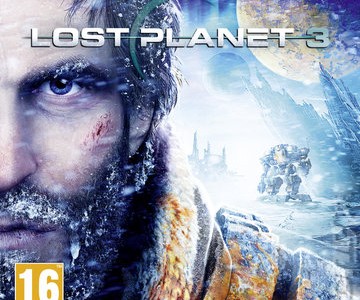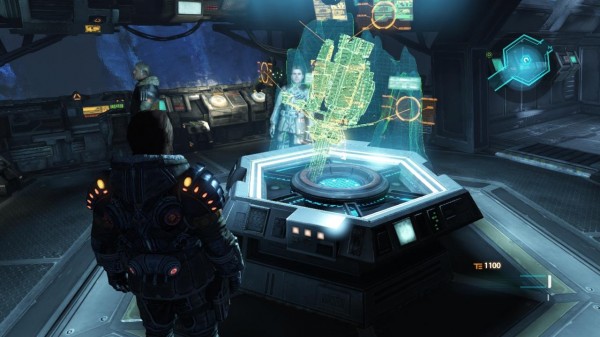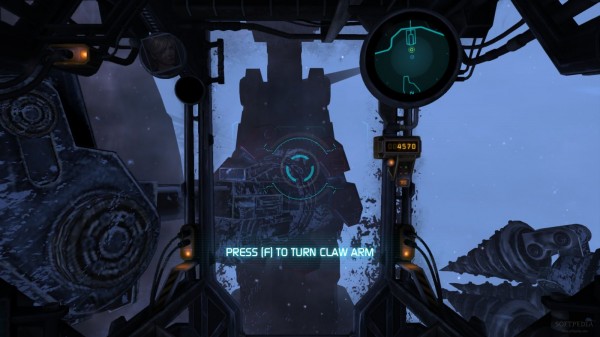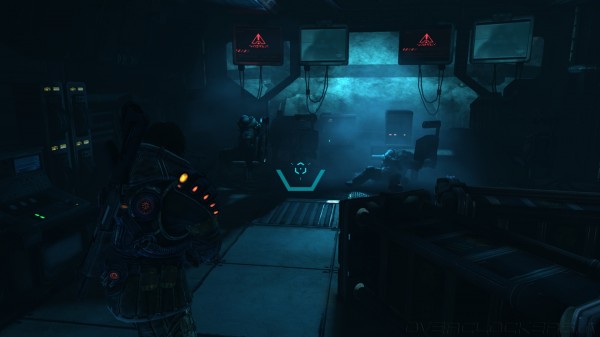Maybe Lost Planet 3, a third- and first-person shooter prequel from Capcom, will make more sense if I explain it as a middle school project.
Middle schoolers will work IN groups, but not AS groups. An example: When a gaggle of middle schoolers is tasked with composing a name for said group, rather than debate the merits of each contributed idea using the principles of democracy to arrive at a distilled representation of the best concepts, they will choose to lump all the non-objectionable ideas together. A Frankenstein is then born, or more accurately, the Jesus Picklechip Rainbow Alpacas.
Lost Planet 3 must be the name Capcom told Spark Unlimited to slap on this thing. The developers probably called it Dead Spaceahontas 3: The Steeliest Battalion Strikes Back during most of the production cycle, for economy and clarity. Curiously, what Spark Unlimited has reappropriated from other games and films is individually compelling. When combined… well, you remember middle school.
There’s the Jim Peyton Story and there’s the Lost Planet Game, and they’ve never met. I beheld both simultaneously when I played Lost Planet 3. I kept looking behind the TV; surely this was a mechanical error, a picture-in-picture gremlin. There’s no way this likable, blue-collar shmoe would be whizzing around the ice-planet E.D.N. III drilling through alien crustacean skulls and uncovering interstellar corruption in a private company’s bid for the ultimate energy source and the salvation of a now-cooling earth. And yet there he is, under my control, and armed with three different weapons and grenades. I smear the ice-crab blood from my screen. “Well, glad that’s over!” he chimes in.
Jim seems like a sweet guy, sent to this distant planet to do odd jobs to send some money back to his wife and kid on earth. The relationships are played out in regularly sprinkled video transmissions between the family, in which Jim’s genuine affection for his wife and child suffuse a kind of ordinary that feels out-of-place in a deadly frozen wasteland. Particularly, Jim’s Georgian drawl transports his mid-combat utterances way off of E.D.N. and into the antebellum South (minus the racism). Why yes, Jim, I’d love to have you and the missus over for Sunday brunch.
Oh wait, you’re on Hoth and your job is murdering gooey ice-beasts. I forgot.
Jim forgets, too. Crawling around a dark ice cavern, his shotgun still hot with bloodsport, the ground trembling at the groans of a mammoth insectoid, he says, “Oh, real nice one, Jim. REAL NICE.” Halfway through a long-buried, alien-infected derelict space craft, past the hallway of dead bodies and blood trails on the walls – THE WALLS – he says, “Now this is just getting weird.” Really, Jim? Now is when this is getting weird?
So it goes on like this, Jim ever affable and coy, and his circumstance ever dire and otherworldly. Both components make sense, but when they collide, there should be some reaction. Jim, for example, losing it, or going native, or anything but more one-liners.
I think Jim’s apparently unphased demeanor is meant to fall under the auspice of “suspended disbelief,”, science fiction’s Get Out Of Jail Free card. It’s the same device that allows the writer to say that humans have discovered a currently undiscovered ice planet, navigated to it, and developed suits to withstand its hostile climate so they can walk around helmet-less in a cataclysmic blizzard. It’s also the device that developers use to justify things we need for most games to function, like recharging health and impermanent death. I’ve made peace with the dissonance, as you no doubt have, too, because otherwise gaming would become a real slog.
The unforgivable sin that Lost Planet 3 commits is mashing together a character, several mini-narratives, and a fascinating setting without allowing any to develop. To be clear, this is a game that doesn’t shy away from complexity in these components, which is laudable in its own right. That doesn’t make Jim’s Avatar storyline any more logical, or his apparent disregard for self-preservation any more confounding. That doesn’t make the framing device of one incredibly long deathbed (cave) story any more plausible, or lend any more intrigue to the tired tracks of the greedy corporation steamrolling the peon with a heart of gold.
Lost Planet 3’s fractured identity doesn’t stop with Jim. What begins as something of a chore simulator with first-person mech segments becomes a horror shooter for a while and finds a familiar pacing towards the end. The mechs, called rigs here and not equipped with the series’ traditional weapons and ultra-mobility, play like mobile quick-time event initiators. Particularly when fighting large Akrid, the rig HUD flashes with shoulder-button prompts, usually ending with a drill to the fleshy orange spots. On-foot battles play out similarly, the formula going evade, attack, evade, attack without much variety. It’s only when human opponents start to populate the field that a cover shooter emerges, introducing a sense of progression.
Gunplay and combat don’t feel too different from the previous entries in the series, though like the Akrid and the rigs, the frenetic bombast has been dialed way down. The grappling hook plays less like a combat aid and more like a traversal tool. Thermal energy is no longer health, but just a currency, leaving the health system to the steadier recharging system. A real innovation comes in melee quick-time events, though, as a right-stick reticle introduces aiming to a desperate knife maneuver.
And when Jim isn’t happily slashing his way through an ecosystem, he meanders into a more-bare hub city of an open-world RPG. The Coronis Station, fittingly a spaceship dangling on the edge of an abyssal gorge, slows down the pace considerably, and not in the right way. Instead of offering world-building lore in environmental detail, or compelling character drama in fruitful side-quests, it adds an elevator and empty hallways. The shops, yeah, they’re still there, but you’ll have to see at least two loading screens for each, and don’t even think about visiting the lab; that’s four loading screens, two elevators, and not much payoff. What could have been an anchor to meaningfully connect the disparate pieces of Jim’s narrative falls into tedium and necessity.
In the middle of this disappointing mélange sits a chapter so oddly separate from the rest that it intrigued me simply with its otherness. It didn’t hurt that it pulled straight from the Dead Space playbook, either. Or that it mimics the Dead Space series in other meaningful ways: ice planet, engineering makeshift weapons, uncovering truth about a corrupt organization by investigating derelict spacecraft, and so on. At least, Jim is is no Isaac.
While investigating an energy signal (or something, I don’t know), Jim melts his way into an abandoned spaceship where, predictably, his radio cuts out. For a good three minutes, he wanders through dark, metallic corridors piecing together the ship’s history in corpses, audio logs, and broken machinery. He pries open a door and is ambushed by a face-hugging Akrid scorpion bursting from the floor. The following rooms and hallways are peppered with jump-scare scorpions (three shots to kill) and flickering lights. Jim turns on some machinery, which opens an airlock door from a previous engineering bay. It all feels eerily familiar.
The next twenty minutes play out like the polished product of a level design class. Triggers and spawns are placed at any well-lit juncture, accented by ebbing, discordant violins. One room needs the hacking minigame, interrupted by combat. Each new objective or hurdle has its own color scheme. Red light and scorpions pour out of the blast door Jim opens. Jim ducks into a vent and a blinding light whitewashes another antechamber. A green glow illuminates the slowly opening pressure door while Jim fends off scorpion waves. Exploding spawn bulbs change Jim’s approach to sniping in the open catwalk space. A projectile-firing Akrid further develops the ranged dynamic into a mixture of dodging and cover shots. Then it confines the same to a smaller space, and mixes in the melee scorpions. It crescendos to an automated turret, a room full of Akrid, and a timed door release. That and, of course, the multi-layer boss the size of the stage.
Maybe the best part of the horror shooter spaceship segment, now that I think about it, was that Jim’s radio went out; he almost kept quiet. And when he did, the conversation between designer and player took off. To me, that’s where an atmospheric shooter should concentrate. Horror naturally implies that conversation; its inclusion in Lost Planet 3 had a briefly sobering effect on Spark Unlimited, I think, reminding them that each of the elements at play needs to hold some formative, inter-operable role that creates a cohesive whole. And when they did it was just a joy to play, and then… well, you know. Middle school.
Of course, there’s multiplayer, too. Of course. The effect of an ill-fitting garment is, at best, unwelcome. Team deathmatch and objective-based scenarios find comfortable homes in fast-paced precision shooters and thoughtful strategy games. Lost Planet 3 is neither, and plods along with its horde mode and its mech scenarios and its Jim Peyton and its frozen foundations and its glowing weak spots like an old man in an old car on a country highway on a planet with a different sun.





















